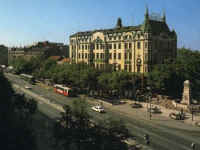Tuesday, 30 September. We had to be up at 6:15 to get our luggage out by 6:45. Breakfast at the hotel
started at 7:00. The day was overcast and a little chilly, but a light rain was gone by the time we boarded
the buses at 8:15 for a city tour. We drove down the left bank of the Sava to a spot with a good view of
the Kalemegdan Fortress and the old city across the river.
We drove back past the Intercontinental and crossed the Sava into the old city. The bus crisscrossed the streets of the city center to the point I couldn't follow on my map. We passed the 25th of May Museum, then a large park where Tito's modest tomb was located. We went by the Federal Police headquarters and later the military headquarters. Both buildings were badly damaged by the NATO bombing in 1999 and have not been repaired. It amazed us, both that they had been bombed in the very heart of the congested downtown area, and that there had been so little collateral damage. We had a stop at the St. Sava Cathedral, largest Orthodox church in the world. Although it is used for special occasions, it is still under construction. The cathedral's foundations were laid in the 1920s and construction continued into the 1940s. It commenced again in 1989, but only went on for a year before funds ran out. Work recently has begun again, but at a slow pace. Back on the bus, we rode by the Yugoslav Parliament (There's also a Serbian Parliament), City Hall, Republican Square, the National Museum, the National Theater (1869), the University, the old Hotel Moskva, and many government buildings. The bus finally took us up to the Kalemegdan Fortress, now the principal city park. The fortress has its roots in ancient times and has been destroyed and rebuilt many times. Most of what remains today was built by the Austrians (early 18th century). We walked a short distance to the main gate in the old walls, passing by an Army Museum exhibit set up in the moat. Inside, the park was swarming with groups of school children, as well as others enjoying the fresh air in spite of the gloomy and windy day. We walked to a parapet overlooking the confluence of the Danube and Sava Rivers. It was easy to see why this site was perfect for a fortress. Then it was goodbye to Belgrade as our bus departed at 11:15 on our long drive to Mohacs, Hungary. By the time we crossed to the north bank of the Danube at Novi Sad about 1:00, the sun was out. The city is in Vojvodina, an autonomous province of Serbia (like Kosovo was). Vojvodina is a very flat, very fertile area, the breadbasket of Serbia. Novi Sad is its largest city.
We ate lunch in Novi Sad. Afterwards the bus dropped us on the north bank of the Danube for a view of
the Petrovardin Fortress (begun 16th century; completed 1776). At the foot of the hill where the
Fortress stood was the pontoon bridge that now carried traffic across the Danube. Just to the right of
that were the supports of the concrete bridge destroyed by NATO bombing in 1999. Janet, our tour
director, told us that it was the inability to get permission to pass through this pontoon bridge that made
it impossible for the M/S River Adagio to sail to Budapest.
The bus left Novi Sad at 2:45, traveling across Vojvodina. The road was far enough from the Danube that we couldn't see Croatia on the opposite bank. Sugar beets were an important crop here, and we saw many trucks and horse or tractor-drawn wagons loaded with them as we drove along. We passed a processing plant where at least a full acre was bright red with beets lying on the ground. We reached the Serbian-Hungarian border at 5:15 but it was 6:00 before we got across. By the time we got to Mohacs (There are two of them!) on the Danube, it was getting dark. As our big bus navigated the narrow streets of the village, neither our local guide nor anyone else knew how the find the river, let alone the Harmony. And none of them spoke Hungarian! Nevertheless, they stopped to ask directions as a dozen or so villagers gathered to watch the spectacle and join in offering advice - in Hungarian, of course. We finally found the narrow street nearest the river and, after a couple of times forward and back, found a place where we could walk around behind the houses to get to the water. We finally got to the boat at 7:45. What made it all the worse was that Janet had told us the drive from Belgrade would take about six hours, so we hadn't reconciled ourselves to an eight and a half hour trip. A buffet was ready on the Harmony as soon as we boarded. (The other three buses had arrived long before ours.) We had the same cabin number as we'd had on the Adagio. The cabin was also the same size, or even slightly larger. We were exhausted and went to bed as soon as we unpacked.
Copyright © 2000-2023 DarrellPeck.com All rights
reserved. | |||||





